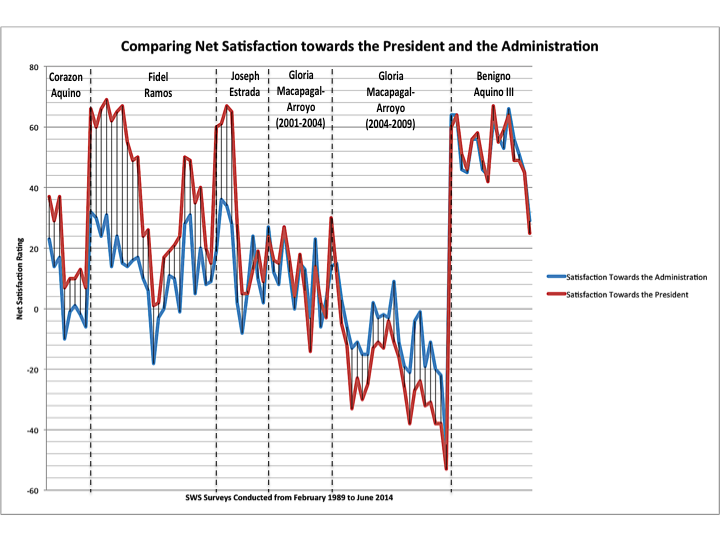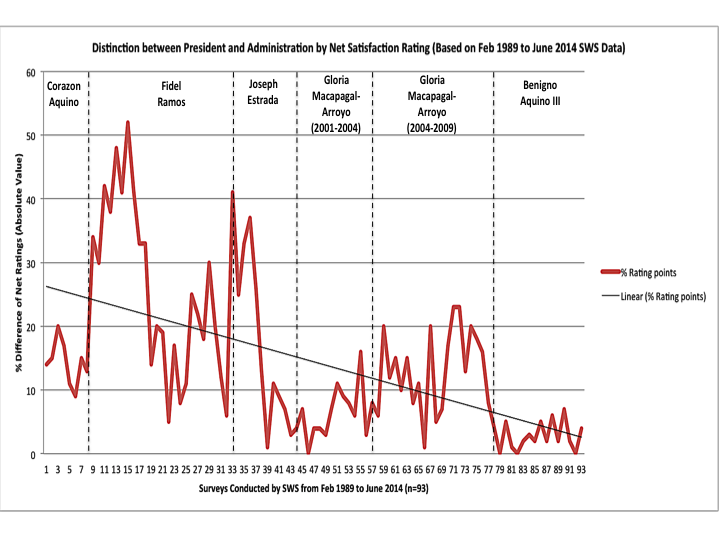I would like to share with you a piece of research I did "on the fly" while I was toying around with the data sets from the Social Weather Station (SWS). Since 1985, the SWS has been conducting research about an array of topics having to do with socio-economic concerns, democratic values, and elections, among others. Let me first disclose though that I am in no way connected with the said organization. As a researcher, I have been familiaried with the datasets which they publicly release. I have always found their data sets useful in my research projects. I find it also helpful that their researches have aided me in learning more about survey research methodology.
While going through their publicly accessible data, I chanced upon the data set which was generated "net satisfaction towards presidents". SWS computes "Net satisfaction ratings as figures of % satisfied minus % dissatisfied correctly rounded". Typically, their surveys cover 1,200 respondents and has a sampling error margin set at +/- 3%. They have been conducting this periodically since 1989. I initially took interest because of my previous research about presidential issue-attention but then realized that I wanted to explore other dimensions of the data. Visit their website for more information regarding the methodology of the surveys -- www.sws.org.ph.
While going through the data set, I wondered about the factors that account for the changes in the net satisfaction ratings of presidents. Thankfully, a critical part of SWS's methodology breaks down the total net satisfaction rating into sub-components. This provides categorical reasons why scores increase or decrease for every political administration. This led me to further question if the respondents of the survey were capable of distinguishing the presidential leadership from the political (organizational) administration. For most Filipinos, I would suspect that this distinction of performance has been blurred, perhaps due to the intensity of personalism and personal attributions in politics. The literature on Philippine politics draws attention to the personalistic character of local politics, to the extent that authoritative personalities who represent organizations are conceptually no different from the organizations which they represent. In short, there has always been an impression that a leader's performance is directly attributed to the performance of the organizations s/he leads and vice versa. In the same light, an assessment of the performance of a political administration was typically an assessment of the president and vice-versa.
So, I had to ask:
Can/Do Filipinos distinguish the President's performance from his/her Administration? Or, do Filipinos consider the performance of the president and the his/her administration one and the same? Has the distinction become apparent across time?
Fortunately, SWS has a separate question in their periodic surveys as regards the satisfaction of respondents towards the administration; this is differentiated from the item on the President. Logically, in a normalized scale, a difference between scores would indicate that respondents are able to distinguish one from the other. The closer the difference moves to zero, the lesser the distinction.
So, what did I find out?
Based on the SWS data set from February 1989 to June 2014, there are observable gaps between the net satisfaction rating of the president and their respective administration. These gaps are apparent for each administration, ever since the surveys were conducted in 1989.
- The widest of gaps which distinguish the president from the administration was during the presidency of Fidel V. Ramos, where the president, in general, gained higher net satisfaction points compared to his administration.
- A similar case is observable during Joseph Estrada's time, however shorter in duration due to his ouster in 2001.
- The distinction between president and administration were pronounced during Gloria Macapagal-Arroyo's presidency, with respondents giving the administration a "higher" net satisfaction ratings than the president herself (although both located in the negative region).
- It appears that, in this periodization, it was during the administration of Benigno Aquino III when there is practically no distinction between president and administration -- President Benigno Aquino III and his administration are viewed as almost one and the same.
Graph 1: (Source: http://www.sws.org.ph/)

By looking at the absolute value of the difference of ratings, the difference between president and administration would tend to gradually move towards indistinguishability across time from 1989 to 2014 ( see linear trend of Graph 2). This becomes even more apparent if the error margins are taken into account. Interestingly, there are certain periods when there was statistically no distinction. These were in November 2001 during the presidency of Joseph Estrada; and November 2010, September 2011, and March 2013, under the current presidency of Benigno Aquino III.
Pearson correlation of the net satisfaction scores are at 0.84 and, as for the significance of the difference in scores, the t-statistic score is (-)3.7, where significant = | t | > 2].
Graph 2: Difference Scores based on net satisfaction ratings between presidents and administrations

Admittedly, the data is limited only to the SWS surveys. The findings in this research are also limited by the methodology set by the survey firm. This definitely raises reliability issues. This is short of saying that a validation from counterpart data sets would be most welcome.
by Jalton Garces Taguibao (2014)


